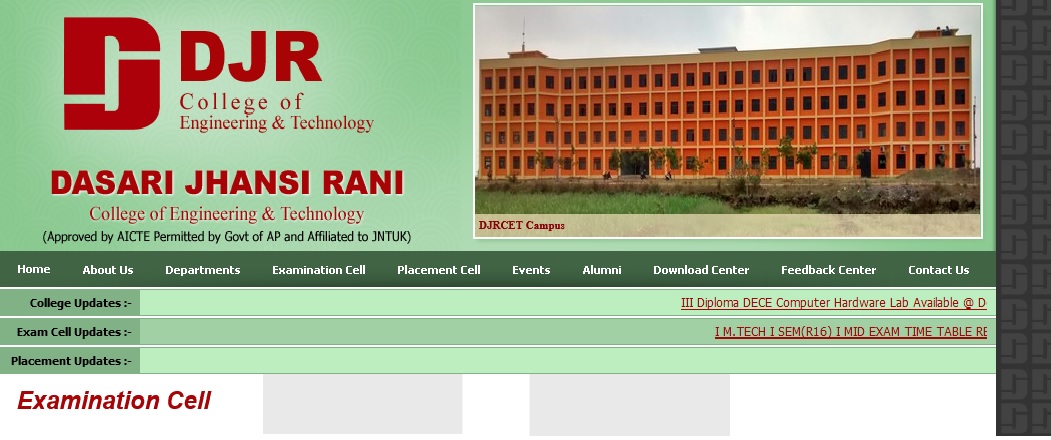Applied Physics B.Tech Question Paper : djriet.edu.in
Name of the College : Dasari Jhansi Rani Institute Of Engineering And Technology
University : JNTUK
Department : Computer Science And Engineering
Subject Code/Name : 07A1BS05 – Applied Physics
Year : 2008
Degree : B.Tech
Year : I
Website : djriet.edu.in
Document Type : Model Question Paper
Applied Physics Supple I Year Aug/Sep 2008: https://www.pdfquestion.in/uploads/djriet.edu.in/2988-07A1BS05-APPLIED-PHYSICS.pdf
Applied Physics Regular I Year May/June 2008: https://www.pdfquestion.in/uploads/djriet.edu.in/2988_07A1BS05-APPLIED-PHYSICS.pdf
DJRIET Applied Physics Question Paper
I B.Tech Supplimentary Examinations, Aug/Sep 2008 :
APPLIED PHYSICS :
( Common to Electrical & Electronic Engineering, Electronics & Communication Engineering, Computer Science & Engineering, Electronics & Instrumentation Engineering, Bio-Medical Engineering, Information Technology, Electronics & Control Engineering, Computer Science & Systems Engineering, Electronics & Telematics, Electronics & Computer Engineering and Instrumentation & Control Engineering)
Time: 3 hours
Max Marks: 80
Related : Dasari Jhansi Rani Institute Of Engineering & Technology Programming & Data Structures B.Tech Question Paper : www.pdfquestion.in/2989.html
Set – I
Answer any FIVE Questions :
All Questions carry equal marks :
1. (a) Define coordination number and packing factor of a crystal.
(b) Describe BCC crystal structure, with a suitable example.
(c) Obtain an expression for the packing factor of FCC structure. [4+6+6]
2. (a) Derive 3-dimensional, time independent Schrodinger wave equation for an electron.
(b) What is the physical significance of wave function?
(c) Deduce the expression for energy of an electron confined to a potential box ofwidth ‘x’. [6+4+6]
3. (a) Discuss with suitable mathematical expressions, the Kronig-Penney model forthe energies of an electron in a metal.
(b) Explain the classification of metals, semiconductors and insulators based on band theory. [10+6]

4. (a) Explain the following:
i. Electric Polarization and
ii. Polarizability.
(b) Derive Clausius-Mosotti relation in dielectrics subjected to static fields.
(c) Argon gas contains 2.70 × 1025 atoms/m3 at 0 0C and at 1 atm. pressure.
Calculate the dielectric constant, if the diameter of argon atom is 0.384 nm.
[4+8+4]
5. (a) Distinguish between intrinsic and extrinsic semiconductors with suitable examples.
(b) Derive an expression for the density of holes in valence band of an intrinsic semiconductor. [8+8]
6. (a) What is population inversion relating to laser action? Explain.
(b) Show that the ratio of Einstein’s coefficient of spontaneous emission to Einstein’s coefficient of absorption, is proportional to the cube of the frequency of the incident photon. [6+10]
7. (a) Describe the structure of an optical fiber.
(b) Explain, in detail, the basic principle of an optical fiber.
(c) Write the applications of fiber optics in medicine and industry. [6+6+4]
8. (a) Write a detailed note on nanoscience.
(b) Why nanomaterials exhibit different properties? Explain. [6+10]
Set – II
1. (a) Explain the formation of an ionic crystal, with a suitable example.
(b) Derive an expression for the cohesive energy of an ionic crystal. [6+10]
2. (a) Show that the energies of a particle in a 3-dimensional potential box, are quantized.
(b) Discuss, in detail, the physical significance of wave function.
(c) A neutron beam of kinetic energy 0.04 eV is diffracted at the plane (1 0 0) of a simple cubic crystal for which d110 is 0.314 nm. Calculate the glancing angle at which first order Bragg diffraction will be observed. [6+4+6]
3. (a) Discuss with suitable mathematical expressions, the Kronig-Penney model for the energies of an electron in a metal.
(b) Explain the classification of metals, semiconductors and insulators based on band theory. [10+6]
4. (a) What are the sources of permanent dipole moment in magnetic materials?
(b) Explain the hysteresis loop observed in Ferro-magnetic materials.
(c) Write notes on Ferro-electricity. [6+6+4]
5. (a) Write notes on direct band gap and indirect band gap semiconductors.
(b) Show that for a p-type semiconductor the Hall coefficient, RH = (1/ne).[8+8]
6. (a) Explain the characteristics of a LASER.
(b) Describe the construction and working of a semiconductor laser.
(c) Write any four applications of laser. [4+8+4]
7. (a) What is the basic principle of holography? Explain.
(b) How to construct and reconstruct a hologram? [6+10]
8. (a) Write a detailed note on nanoscience and nanotechnology.
(b) Write the important applications of nanomaterials in medicine. [10+6]